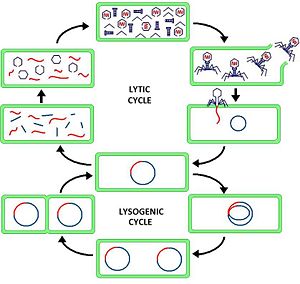Lysogenic cycle
Lysogenic cycle, or lysogeny, is one of the two alternative life cycles of a virus inside a host cell, whereby the virus that has infected a cell attaches itself to the host DNA and, acting like an inert segment of the DNA, replicates when the host cell divides. This method of replication is contrasted with the lytic cycle, whereby the virus that has entered a cell takes over the cell's replication mechanism, makes viral DNA and viral proteins, and then lyses (breaks open) the cell, allowing the newly produced viruses to leave the now disintegrated host cell to infect other cells. While the lysogenic cycle causes no harm to the host cell, an induction event, such as exposure to ultraviolet light, can cause this latent stage to enter the lytic cycle.
The lysogenic cycle is one strategy for replication of the virus without destruction of the host. The discovery of this cycle has important medical implications. Sometimes expression of the genes of a lysogenic bacteriophage can alter the phenotype of the host bacteria. This phenomenon, called lysogenic conversion, can have medical significance for humans. For example, the bacteria that causes diptheria, Corynebacterium diphtheriae, is harmless to humans unless it is infected by the phage β. Then the genes of the incorporated DNA of the bacteriophage induce the host bacteria to produce toxins.
Overview
Viral reproduction is most fully understood through studying viruses that infect bacteria, known as bacteriophages (or, commonly, phages). The lysogenic cycle and the lytic cycle are two fundamental reproductive processes that have been identified. The following is a description of these cycles based on bacteriophages.
The lytic cycle involves the virus entering a host cell, taking control of the host DNA to produce viral DNA and the viral proteins that provide the structural component of the bacteriophage, and then, when the cell has many new virus particles assembled, digesting the host cell wall from within and releasing the new viruses. For example, the bacteriophage lambda, after infecting an E. coli host cell, normally multiplies until several hundred progeny are produced, at which time the bacterial cell is lysed and the progeny released (Alberts et al. 1989).
The lysogenic cycle involves the virus entering the cell, and instead of creating new virus particles, is characterized by integration of the bacteriophage nucleic acid into the host bacterium's genome. The newly integrated genetic material acts as an additional set of genes that can be replicated when the DNA of the host cell is replicated and the host cell divides. The virus is thus transmitted to daughter cells at each subsequent cell division, although the phages remain inert, causing no harm to the host cells. Lysogenic cycles can also occur in eukaryotes, although the method of incorporation of DNA is not fully understood.
Prophage is the term for a phage DNA in its dormant state, typically integrated into the host bacteria's chromosome, but also can include the rare cases where the phage exists as a stable plasmid within the host cell.
The lysogenic bacterium multiples normally until some environmental induction, such as ionizing radiation or ultraviolet light threatens the bacterial cell and induces the prophage to initiate the lytic cycle. The prophage expresses gene(s) that repress the phage's lytic action, and the phage enters the lytic cycle when this suppression is disrupted.
Temperate phages are those phages able to undergo both a lytic cycle and a lysogenic cycle, such as the lambda phage. They lyse a small fraction of bacterial cells; in the remaining majority of the bacteria, the phage DNA becomes integrated into the bacterial chromosome and replicates along with it. In this lysogenic state, the information contained in the viral nucleic acid is not expressed.
Lysogenic conversion
In some interactions between lysogenic phages and bacteria, lysogenic conversion may occur. It is when a temperate phage induces a change in the phenotype of the bacteria infected that is not part of a usual phage cycle. Changes can often involve the external membrane of the cell by making it impervious to other phages or even by increasing the pathogenic capability of the bacteria for a host.
Examples:
- Corynebacterium diphtheriae produces the toxin of diphtheria only when it is infected by the phage β. In this case, the gene that codes for the toxin is carried by the phage, not the bacteria.
- Vibrio cholerae is a non-toxic strain that can become toxic, producing cholera toxin, when it is infected with the phage CTXφ
- Clostridium botulinum causes botulism
- Streptococcus pyogenes causes scarlet fever
- Shiga toxin
Extra genes present in prophage genomes that do not have a phage function but (may) act as fitness factors for the bacterial host are termed "morons" (Canchaya et al. 2003).
ReferencesISBN links support NWE through referral fees
- Alberts, B., D. Bray, J. Lewis, M. Raff, K. Roberts, and J. D. Watson. Molecular Biology of the Cell, 2nd edition. New York: Garland Publishing, 1989. ISBN 0824036956.
- Canchaya, C., C. Proux, G. Fournous, A. Bruttin, and H. Brüssow. Prophage genomics. Microbiol. Mol. Biol. Rev. 67(2): 238–76. PMID 12794192. Retrieved November 8, 2008.
- Towle, A. 1989. Modern Biology. Austin, TX: Holt, Rinehart and Winston. ISBN 0030139198.
Credits
New World Encyclopedia writers and editors rewrote and completed the Wikipedia article in accordance with New World Encyclopedia standards. This article abides by terms of the Creative Commons CC-by-sa 3.0 License (CC-by-sa), which may be used and disseminated with proper attribution. Credit is due under the terms of this license that can reference both the New World Encyclopedia contributors and the selfless volunteer contributors of the Wikimedia Foundation. To cite this article click here for a list of acceptable citing formats.The history of earlier contributions by wikipedians is accessible to researchers here:
The history of this article since it was imported to New World Encyclopedia:
Note: Some restrictions may apply to use of individual images which are separately licensed.
